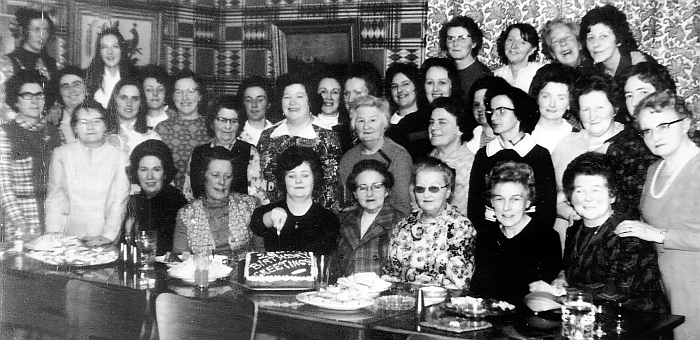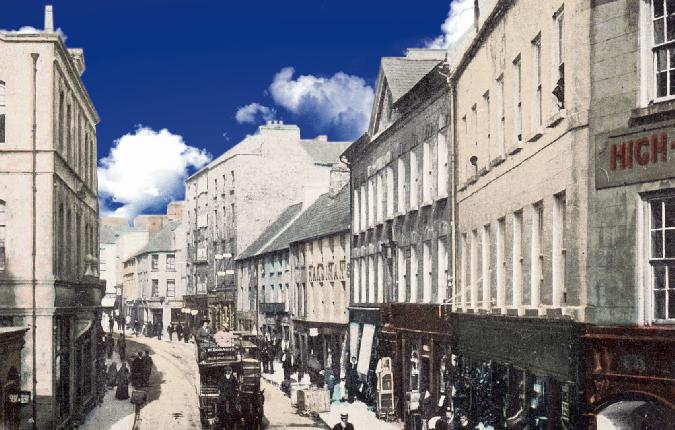Archive News
October 7, 2010

Date Published: {J}
1910
Wife assault
A Ballinasloe woman summoned her husband for assault. The complainant stated her husband left the house about six weeks ago and returned last Monday night week. On Saturday last he came down to the house and broke 9 panes of glass and cracked 7.
On Wednesday, he again came to the house at 8.15, and when he was inside he turned the key in the door and said he would kill her. He struck her on the side of the head with his fist and took a glass and threw it at her. He again threatened to kill her when she told the police.
D.I. Gamble stated that McDonnell was under a rule of bail. A witness stated he saw the defendant coming from Bolger’s lane to his own house and having gone inside locked the door. He heard a row going on inside and he burst in the door. Defendant had a key in his hand.
He took him outside, but did not see him strike his wife. He also saw defendant throw a glass, but he did not know whether it was at his wife or daughter.
In reply to the Chairman of the Petty Sessions, witness said he was not present all the time while the town was going on. Sergeant Connolly stated that the defendant was bound to the peace for assaulting his son, and was a man of very bad character.
Chairman: He is sentenced to two months in gaol.
Evil tipplers
The Pro-Cathedral, Galway was crowded to its utmost capacity on Sunday night when the quarterly meeting of the St. Patrick’s Temperance League of the West was held. After the Rosary, the Rev. P. Lydon, C.C., preached an instructive and practical sermon on the evils of tippling.
Between moderation and excess, he said, there was a path of intemperance more or less sinful. He alluded to the path taken by the systematic drunkards, whom one never could say had “crossed the line”. Though they were always under the influence of drink, they were not drunk: they tippled and tippled, becoming sots and spoiling their lives, losing all qualities of manliness, uprightness and honour.
The life of a tippler became as a garden where nothing grew but rank and noxious weeds. He was a greater menace to society than the drunkard, because the drunkard only inspired derision and contempt.
The tippler produced no such feeling, but appeared to be always jolly, always a good fellow, and led others into his besotted condition of sinfulness. A man who lived in this condition was incapable of resisting temptation, or of living an upright and manly life.
1935
English in schools
The question of Irish in examinations for public appointments was the subject of a long discussion at a conference of delegates from County Galway branches of the Gaelic League held in St. Ignatius College, Galway, on Saturday. Tomas O’Deirg, Minister for Education, was criticised for his attitude on the question.
Padraig Feeney said that in a recent examination for woodwork teachers through Irish, the questions were entirely in English on the paper and related to films or Hollywood stars with which only city people would be acquainted. There had been no centre for that examination in Connacht. He considered that the standard of English for public examinations of this kind was too high and the standard of Irish was too low.
Mr Waldron said that the fact that the Government do not hold Irish should be a necessary subject for the intermediate and leaving certificate examination was a sign that they were bending the knee to the foreign element in Dublin.
Hollywood star
Mr. Charles (Buddy) Rogers, the well-known American film star, paid a short visit to Galway on Wednesday. Mr Rogers had long wished to visit Ireland, particularly the West, and a short break between films in which he is engaged gave him the opportunity of fulfilling this desire.
He flew from Croydon to Dublin on Tuesday, and arrived in Galway on Wednesday morning. He missed the Dun Aengus to Aran, but chartered a motorboat at Costelloe to which he had travelled by road.
Mr. Rogers returned to Galway on Thursday morning and left for Dublin by the 3.30 train.
Mr. Rogers was shown over the city by Miss Kathleen Curran, of the Galway Steamship Company, and expressed himself as being delighted with everything he saw.
Ticket fraud
The Connacht Senior Football Final had a sequel at Roscommon District Court on Tuesday before Mr. J.P. Kenny, D.J. when two men were charged with having conspired with persons unknown to defraud the Gaelic Athletic Association Ltd by collecting and reselling used admission tickets to Roscommon Sports Field, and by unlawfully receiving money for said tickets from persons unknown entering the field on July 21. Both men were fined £2 each and £2 10s in expenses.
For more, read this week’s Connacht Tribune.
Galway in Days Gone By
The way we were – Protecting archives of our past

People’s living conditions less than 100 years ago were frightening. We have come a long way. We talk about water charges today, but back then the local District Councils were erecting pumps for local communities and the lovely town of Mountbellew, according to Council minutes, had open sewers,” says Galway County Council archivist Patria McWalter.
Patria believes we “need to take pride in our history, and we should take the same pride in our historical records as we do in our built heritage”. When you see the wealth of material in her care, this belief makes sense.
She is in charge of caring for the rich collection of administrative records owned by Galway County Council and says “these records are as much part of our history as the Rock of Cashel is. They document our lives and our ancestors’ lives. And nobody can plan for the future unless you learn from the past, what worked and what didn’t”.
Archivists and librarians are often unfairly regarded as being dry, academic types, but that’s certainly not true of Patria. Her enthusiasm is infectious as she turns the pages of several minute books from Galway’s Rural District Councils, all of them at least 100 years old.
Part of her role involved cataloguing all the records of the Councils – Ballinasloe, Clifden, Galway, Gort, Loughrea, Mountbellew, Portumna and Tuam. These records mostly consisted of minutes of various meetings.
When she was cataloguing them she realised their worth to local historians and researchers, so she decided to compile a guide to their content. The result is For the Record: The Archives of Galway’s Rural District Councils, which will be a valuable asset to anybody with an interest in history.
Many representatives on these Councils were local personalities and several were arrested during the political upheaval of the era, she explains.
And, ushering in a new era in history, women were allowed to sit on these Rural District Councils – at the time they were not allowed to sit on County Councils.
All of this information is included in Patria’s introductory essay to the attractively produced A4 size guide, which gives a glimpse into how these Rural Councils operated and the way political thinking changed in Ireland during a short 26-year period. In the early 1900s, these Councils supported Home Rule, but by 1920, they were calling for full independence and refusing to recognise the British administration.
“I love the tone,” says Patria of the minutes from meetings. “The language was very emotive.”
That was certainly true of the Gort Rural District Council. At a meeting in 1907, following riots in Dublin at the premiere of JM Synge’s play, The Playboy of the Western World the councillors’ response was vehement. They recorded their decision to “protest most emphatically against the libellous comedy, The Playboy of the Western World, that was belched forth during the past week in the Abbey Theatre, Dublin, under the fostering care of Lady Gregory and Mr Yeats. We congratulate the good people of Dublin in howling down the gross buffoonery and immoral suggestions that are scattered throughout this scandalous performance.
For more from the archives see this week’s Tribunes here
Archive News
Galway have lot to ponder in poor show

Date Published: 23-Jan-2013
SLIGO 0-9
GALWAY 1-4
FRANK FARRAGHER IN ENNISCRONE
GALWAY’S first serious examination of the 2013 season rather disturbingly ended with a rating well below the 40% pass mark at the idyllic, if rather Siberian, seaside setting of Enniscrone on Sunday last.
The defeat cost Galway a place in the FBD League Final against Leitrim and also put a fair dent on their confidence shield for the bigger tests that lie ahead in February.
There was no fluke element in this success by an understrength Sligo side and by the time Leitrim referee, Frank Flynn, sounded the final whistle, there wasn’t a perished soul in the crowd of about 500 who could question the justice of the outcome.
It is only pre-season and last Sunday’s blast of dry polar winds did remind everyone that this is far from summer football, but make no mistake about it, the match did lay down some very worrying markers for Galway following a couple of victories over below par third level college teams.
Galway did start the game quite positively, leading by four points at the end of a first quarter when they missed as much more, but when Sligo stepped up the tempo of the game in the 10 minutes before half-time, the maroon resistance crumbled with frightening rapidity.
Some of the statistics of the match make for grim perusal. Over the course of the hour, Galway only scored two points from play and they went through a 52 minute period of the match, without raising a white flag – admittedly a late rally did bring them close to a draw but that would have been very rough justice on Sligo.
Sligo were backable at 9/4 coming into this match, the odds being stretched with the ‘missing list’ on Kevin Walsh’s team sheet – Adrian Marren, Stephen Coen, Tony Taylor, Ross Donovan, David Kelly, David Maye, Johnny Davey and Eamon O’Hara, were all marked absent for a variety of reasons.
Walsh has his Sligo side well schooled in the high intensity, close quarters type of football, and the harder Galway tried to go through the short game channels, the more the home side bottled them up.
Galway badly needed to find some variety in their attacking strategy and maybe there is a lot to be said for the traditional Meath style of giving long, quick ball to a full forward line with a big target man on the edge of the square – given Paul Conroy’s prowess close to goal last season, maybe it is time to ‘settle’ on a few basics.
Defensively, Galway were reasonably solid with Gary Sice at centre back probably their best player – he was one of the few men in maroon to deliver decent long ball deep into the attacking zone – while Finian Hanley, Conor Costello and Gary O’Donnell also kept things tight.
For more, read this week’s Connacht Tribune.
Archive News
Real Galway flavour to intermediate club hurling battle in Birr

Date Published: 23-Jan-2013
images/files/images/x3_Courthouse.jpg










